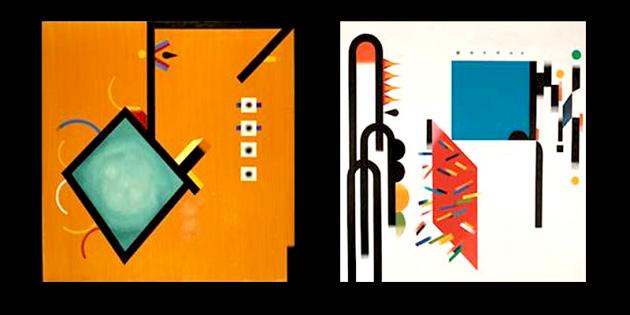A selection of rarely seen abstract paintings by the important British artist Jack Smith has gone on show at the National Portrait Gallery, London, in the Gallery’s first display to focus on entirely non-figurative portraits, it was announced today.
Jack Smith: Abstract Portraits (18 March – 31 August 2015) is the latest display at the National Portrait Gallery to focus on unconventional approaches to portraiture and will be the first time that the Gallery has shown a selection of paintings which exclude any obvious human features.
Included in this display of unusual and striking portraits, organised in partnership with Flowers Gallery, will be two large paintings of the renowned composers Sir Harrison Birtwistle and Colin Matthews (pictured above), who have been represented by Smith solely through a combination of bold, contrasting colours, abstract shapes and strong lines.
Rather than depicting the physical appearances of Birtwistle and Matthews, Smith used his own interpretation of the composers’ music to convey a sense of identity in each of the portraits. He explained, ‘their music is who they are, really… So I had to find forms and language that would tell me something about their music’. Speaking of Birtwistle’s portrait, he described it as a ‘diagram’ of the ‘experience or sensation’ that his music provoked.
The portraits were painted by Smith after he was commissioned to design the sets and costumes for Ballet Rambert’s production of Carmen Arcadiae MechanicaePerpetuum with music composed by Birtwistle in 1986, and the Royal Ballet’s Pursuit with music by Matthews in 1987. Both ballets were choreographed by Ashley Page, whose portrait by Smith will also be included in the display.
Jack Smith: Abstract Portraits is the latest display in the Gallery’s series of Interventions, a programme of special twentieth century displays that focuses on unconventional approaches to portraiture by important, internationally recognised artists. Since 2006, the displays in this series have featured artists who have explored alternative means of representing a sitter, including Francis Bacon, Anthony Caro and Andy Warhol.
Paul Moorhouse, Curator of Twentieth Century Portraits at the National Portrait Gallery, London, says:
‘This display of Jack Smith’s abstract portraits is a first for the National Portrait Gallery as Smith’s paintings dispense with human appearance entirely. These paintings take the Gallery’s Interventions series one step further, not only presenting an unconventional approach to portraiture but, in this case, raising a provocative question: is a person’s appearance a necessary constituent of portraiture or are there are other ways of evoking a human presence?’
Jack Smith (1928 – 2011) first attained recognition as a key member of the ‘Kitchen Sink’ school in the 1950s, a label applied by the critic David Sylvester to the group of artists who first started working in the powerful urban realist style that dominated painting in Britain during that period. Smith first exhibited at Helen Lessore’s celebrated Beaux Arts Gallery in London in 1953 and he showed at the Venice Biennale in 1956, the year in which he won first prize at the Liverpool John Moores exhibition. He was given his first solo retrospective at the Whitechapel in 1959, the youngest artist to achieve this. Subsequently influenced by American abstract painting, Smith’s work changed course during the 1960s and a second solo exhibition at Whitechapel Art Gallery followed in 1971, by which time his work had become almost entirely abstract. Smith’s subsequent career has been celebrated for his completely non-figurative work, which he continued until his death in 2011.
Jack Smith Rarely Seen Abstract Portraits To Be Exhibited At NPG

